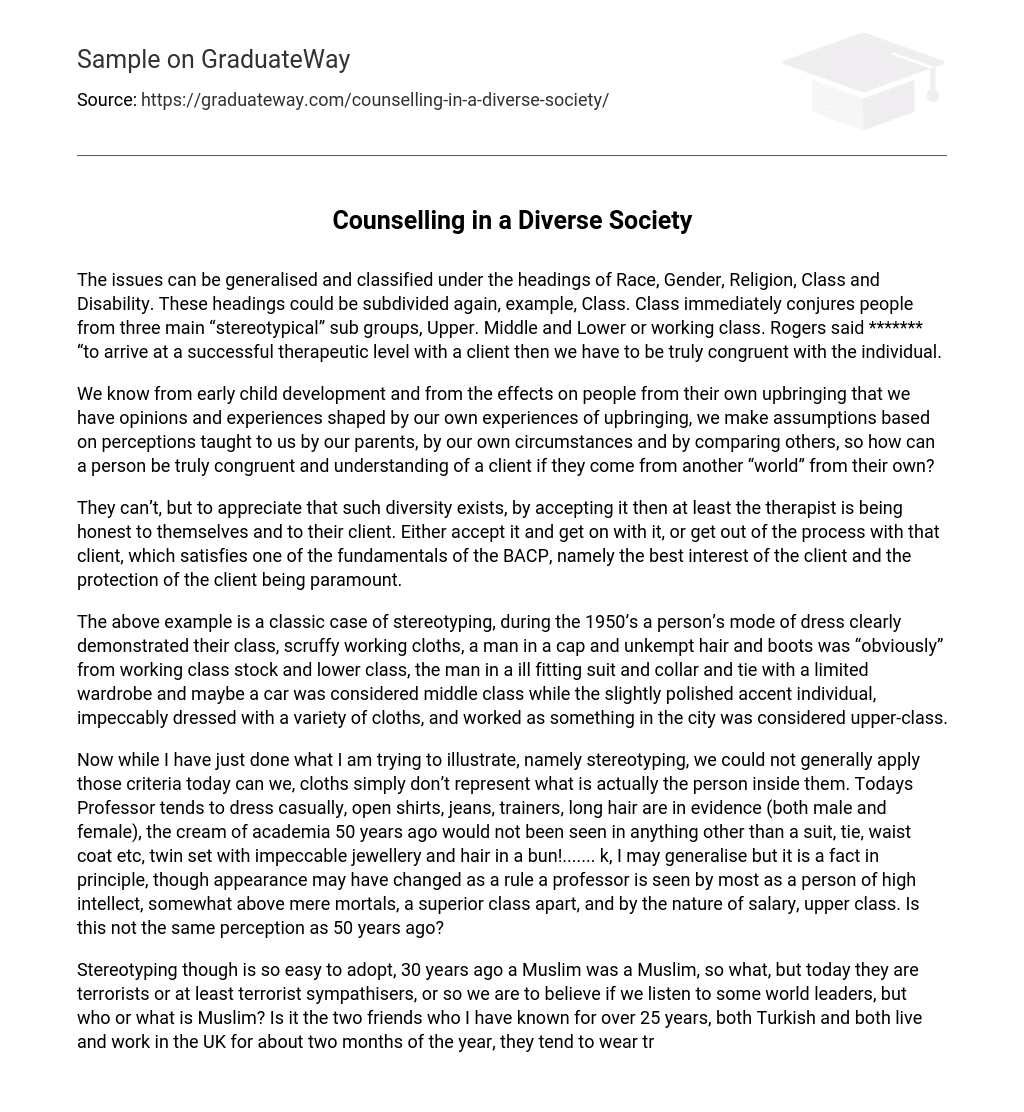The issues can be generalised and classified under the headings of Race, Gender, Religion, Class and Disability. These headings could be subdivided again, example, Class. Class immediately conjures people from three main “stereotypical” sub groups, Upper. Middle and Lower or working class. Rogers said ******* “to arrive at a successful therapeutic level with a client then we have to be truly congruent with the individual.
We know from early child development and from the effects on people from their own upbringing that we have opinions and experiences shaped by our own experiences of upbringing, we make assumptions based on perceptions taught to us by our parents, by our own circumstances and by comparing others, so how can a person be truly congruent and understanding of a client if they come from another “world” from their own?
They can’t, but to appreciate that such diversity exists, by accepting it then at least the therapist is being honest to themselves and to their client. Either accept it and get on with it, or get out of the process with that client, which satisfies one of the fundamentals of the BACP, namely the best interest of the client and the protection of the client being paramount.
The above example is a classic case of stereotyping, during the 1950’s a person’s mode of dress clearly demonstrated their class, scruffy working cloths, a man in a cap and unkempt hair and boots was “obviously” from working class stock and lower class, the man in a ill fitting suit and collar and tie with a limited wardrobe and maybe a car was considered middle class while the slightly polished accent individual, impeccably dressed with a variety of cloths, and worked as something in the city was considered upper-class.
Now while I have just done what I am trying to illustrate, namely stereotyping, we could not generally apply those criteria today can we, cloths simply don’t represent what is actually the person inside them. Todays Professor tends to dress casually, open shirts, jeans, trainers, long hair are in evidence (both male and female), the cream of academia 50 years ago would not been seen in anything other than a suit, tie, waist coat etc, twin set with impeccable jewellery and hair in a bun!……. k, I may generalise but it is a fact in principle, though appearance may have changed as a rule a professor is seen by most as a person of high intellect, somewhat above mere mortals, a superior class apart, and by the nature of salary, upper class. Is this not the same perception as 50 years ago?
Stereotyping though is so easy to adopt, 30 years ago a Muslim was a Muslim, so what, but today they are terrorists or at least terrorist sympathisers, or so we are to believe if we listen to some world leaders, but who or what is Muslim? Is it the two friends who I have known for over 25 years, both Turkish and both live and work in the UK for about two months of the year, they tend to wear traditional Turkish cloths. Turkey is a Muslim state so they are Muslims, they must be……. ell no actually, one isn’t, she is a Christian…………. her son wears western cloths, in fact a few years ago he wore a hoodie, trackie and trainers so he must have been a bit of a “lad”, nope, he was just young and studying for his A levels here in the UK. The very fact that we can think like this could affect the counselling relationship and if it affects the three core principles of UPR, Empathy and Congruence then it is a relationship that needs to cease. Another counselling barrier is language.
Language differences (Accents, inflections and emphasis and translation) are probably (my view) the most important stumbling block to effective multicultural counselling, “Language barriers impede the counselling process when clients cannot express the complexity of their thoughts and feelings” ( Romero, 1985). If this is the case then a client will resist discussing the affectively charged issues which they bring to the room.. Counsellors, too, may also become frustrated by their lack of bilingual or interpretational ability. At the worst, language barriers may lead to misdiagnosis and inappropriate placement (Romero, 1985)” to a counsellor it may mean that there are parts of a conversation that we may not understand or more importantly we think we understand when in fact a client means something else. And Language is not confined to the spoken word, body language is different between cultures, arms folded and sitting backwards is an aggressive or form of resistance in the UK, but in China it is a form of concentration and respect for the other while in conversation.





